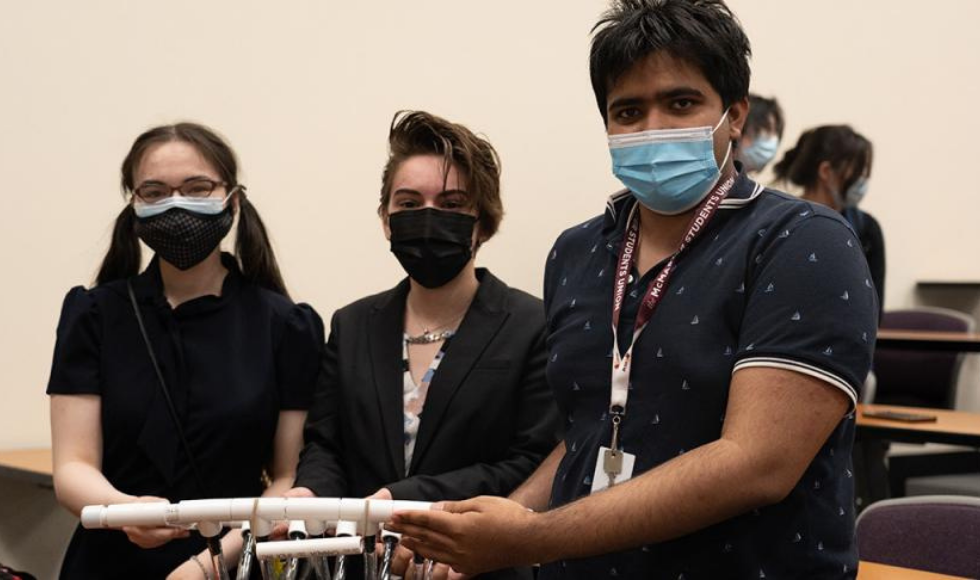First-year Mac Eng students present assistive designs in year-end showcase

The first-year engineering students were tasked with designing a product that would help a client with Ehlers-Danlos syndrome, a disease that weakens the connective tissues of the body, perform daily tasks.
First-year engineering students presented their innovative designs from 1P13 in front of their peers and a panel of faculty judges at the 2022 year-end showcase. Here’s a recap of some of the fantastic projects, including the recipient of “Top Design.”
Engineering students are capping off their first year at McMaster University by showcasing uniquely designed devices.
Over the past eight months, students had been building a portfolio of design projects as part of 1P13: a hands-on, one-of-a-kind course that was developed as part of The Pivot to foster technical and professional skills across various engineering streams.
For their fourth and final project, students were tasked with designing a product that would help a client with Ehlers-Danlos syndrome, a disease that weakens the connective tissues of the body, perform daily tasks.
This is the second year that 1P13 has operated, and the first time students have presented their final projects in-person.
Colin McDonald, one of eight instructors for the course, explained how 1P13 is “very much student driven” – how the collaboration of learning, developing a prototype, failing and recovering are all completed in an environment where students can be successful together.
“The last project…is where students have the opportunity to springboard and explore and really tailor their own learning to something that meets the client’s needs, but also excites them and motivates them – because that’s really when learning happens,” he said.
From enjoying a cup of tea to playing board games with family, here are some of the top projects from this year’s showcase.
Top Design
Dish Assistant
Zoë Carter, Christopher Hoftyzer, Safwan Khan, Adriana Toito
The Dish Assistant helps make washing dishes a less painful and less strenuous process: as the Ehlers-Danos syndrome affects the client’s connective tissues, he finds this daily action incredibly tiring and labour intensive.
Zoë Carter explained how the client’s fingers would have trouble holding onto dishes, and how his back and shoulder strain would accumulate, resulting in him breaking up the dishwashing process into multiple stages.
The device sits on the inside of the sink and at a higher level so that users don’t have to excessively lean over to wash a dish. It’s also able to hold dishes, which can easily be dropped by the client as they become slippery with soap.
“We wanted something that would alleviate some of the stresses,” Carter said.
Carter explained how the Dish Assistant is light in weight – only 2.2 pounds – and comes with handles that allow it to be transported. The group ensured it could be taken apart and reassembled to fit sinks of various sizes and tested its capacity to hold at least five pounds of dishes.
Reaching their goals for the product required continual dialogue between team members; Carter said the flow of feedback is what helped it come together.
“We were constantly bouncing off ideas against everyone and changing it as we went along to really maximize how good our product was,” Carter said.
“We got to design things on our own, produce things, hold our physical product and even consider materials and costs and construction. It’s a very good experience and a great introduction.”
“I often doubt myself throughout the projects, but working with my friends – my classmates who became my friends – built a lot of confidence to just go after ideas, even if they sound crazy because they can work.”
1P13 Showcase Finalists
James Games
Sebastian Acevedo Franco, Alexis Bouchard, Annika Culhane, Jacob Kish
James Games is an ergonomic device that helps the client play board games more easily. The group handmade a wooden turntable and laser cut a reaching tool that helps to push, pull and pick up various game pieces. The device also adapts to board games of different sizes as needed.
Annika Culhane, who is also a 2021 Schulich Leader, explained that the group was drawn to the concept of creating a board game device because of the open-ended possibilities. The group filtered through many ideas to negotiate and narrow down elements to include.

“There’s so much that goes into playing board games…we have a lot of different things to explore and we thought it’d be a great learning experience,” Culhane said.
“We had an ambitious idea and we knew there was a lot to go into the fabrication…It all came together and it was a relief and was exciting too, knowing that we could proceed with all our test plans.”
Culhane said she’s leaving 1P13 with new technical skills, including coding experience, and knowledge on how to apply the design process to future projects.

Handular
Aayan Siddiqui, Alex Trinh, Spencer Vandenbosch
Handular is a device that assists in pouring a teapot. By hooking the mechanism on to both the handle and spout end of the teapot, the client is able to distribute the weight and pour. This action normally strains the client’s hand, often resulting in dislocation of joints; having the horizontal handle above the teapot makes pouring more ergonomic.
Alex Trinh explained how the group persevered through trial and error, breaking down problems that arose and exploring new possibilities for a better product.
“We were constantly refining our solution to make it more viable,” Trinh said. “We were very elated to see that it actually worked and that our final product was something that we could come up pretty proud with.”
“This experience has been very humbling. I think going into high school, you don’t really get much opportunity to do any engineering-related stuff. Going into this program, it really gives you the opportunity to experience engineering hands on.”
Connect LED
Andre Azevedo, Isaac Ham, Sriram Janarthanan, Pega Liu
Connect LED repurposes the classic game of “Connect 4” through the use of lights. As the client has trouble lifting his shoulders and reaching out his hand, the students replaced physical tokens, normally dropped down into a grid, with LED bulbs. The client can control the game remotely using a controller.
Pega Liu explained that the students had the client’s bond with his grandchild at the forefront of their minds. They wanted to make it small, not only for engineering purposes, but also so that the grandchild could enjoy playtime too.
The main challenge was the circuit board: there were six rows and seven columns, with two colours for the tokens. Taking into account 80 LEDs and wiring cables across the space worked out to more than 500 points to contend with, Pega said.
What helped, he said, was that the team could be confident in each group member’s work.
“I really appreciate my teammates, what my teammates do. That’s my big takeaway: how to work in teams with other people.”
The Joystiqq Qeeboard 3000
Stefan Balta, Mary Pangowish, Aneesa Shaikh, Natalie Yuen
The Joystiqq Qeeboard 3000 aims to increase accessibility of a computer keyboard through software and accompanying joystick. The group selected 10 keys on a standard keyboard that fell into the client’s natural hand positioning; using those keys, which are arranged directly above each other, and combinations of movements on a joystick, the client is able to access the keyboard in its entirety.
Stefan Balta said the team wanted to combine their strengths of programming and modelling to create a software-based product; he explained how the students would organize tasks among the group and help one another through the work.
He recalled McDonald raising the element of trust among collaborators in one of his early lectures.
“Teamwork is important,” Balta said, noting that students opened up and shared the workload in order to be successful. “That was a big takeaway.”
The course, Balta said, teaches students how to avoid getting lost in a “rabbit hole” of possibilities and hone in on their ideas.
“It was a lot of fun and I’ve been dreaming about being an engineer since I was a kid. So having a course like this, I think it brought out the best in a lot of people.”
Honourable Mention
LEDice
Haniye Hamidizadeh, Rawan Mahdi, Lily Porter, Isaac Thomas
The LEDice uses bulbs to electrify dice rolling. The device has LED bulbs in the pattern of dots on a die; with sensors on the front and side, the client is able to wave their hand to activate and “roll” one die or two, respectively.
Lily Porter said the group was inspired by the client’s connection with their family and the joy of playing board games in their own lives.
While the group started with complicated designs, Porter explained that they quickly put effort into this prototype. Using teamwork, they were able to make it more compact.
The process of designing was something that drew Porter into coming to the university.
“That’s one of the reasons why I wanted to come to McMaster for engineering in the first place – because I knew that they did a design project like this,” Porter said.
“I think it’s super important. One of the cool things about this specific course in this design studio is you get to work in a team with other people… it’s more realistic to what the actual workplace is like when you’re in engineering. You’re not going to be doing things by yourself. You’re always gonna be working in a team. So this gives you lots of experience on how all that works.”
Does the idea of being an engineer light a fire in you?
Are you interested in 1P13?
Here’s some advice from students who went through the experience!
Zoë Carter: “It’s super fun. You’ll meet lots of great classmates and everyone is really supportive and great to work with. There’s lots of different things you can learn about and there’s something for everyone’s tastes and expertise.”
Alex Trinh: “Keep an open mind because a lot of the things that you’re going to be learning are from many different engineering disciplines.”
Annika Culhane: “Start broad, chase after what you like, but don’t go with your very first thought…You need to brainstorm, you need to try crazy things and see what ends up working, whatever it is.”
Stefan Balta: “It’s a lot of work, but it’s also worth it if you do it… We learn material science, computing, and modeling. We learned a lot of how to take a project from start to finish and I think that’s critical and it’s really cool.”
Pega Liu: “Relax…as long as you listen to your lectures and talk to your teammates, you’ll get something really amazing done.”
Lily Porter: “It’s definitely not going to be like a course that you’ve ever done before…it’s probably something that you’ve never seen before. I think that would be a little bit scary because it’s so new, but I say just go into it with an open mind.”







